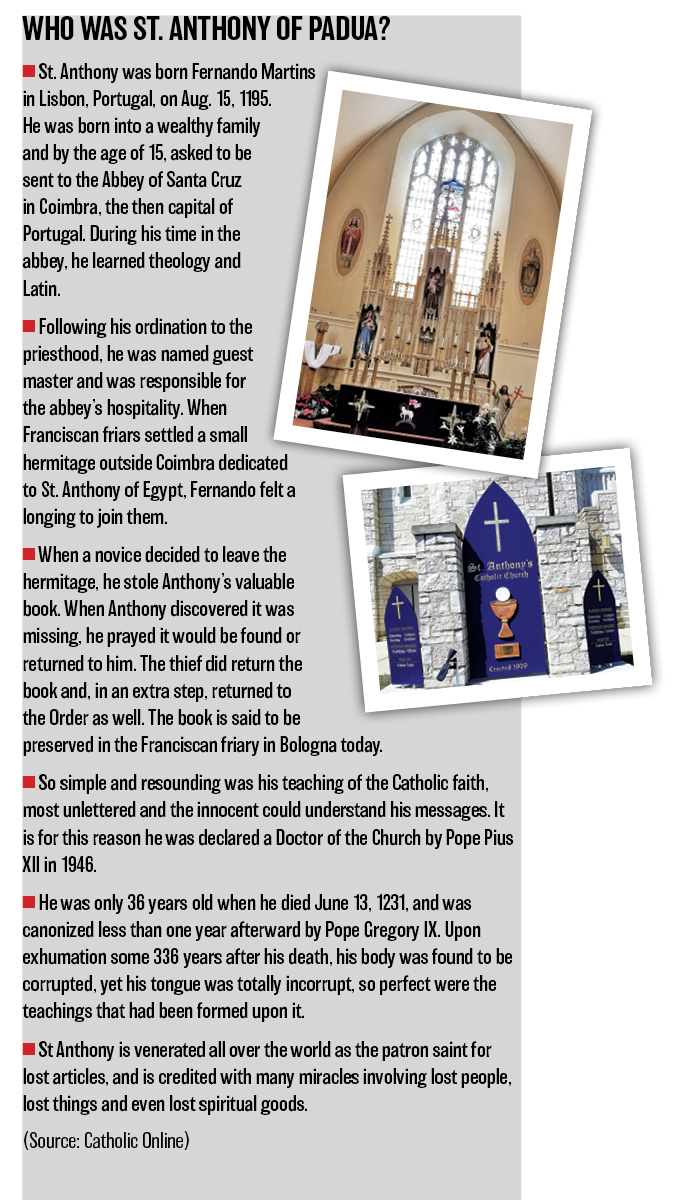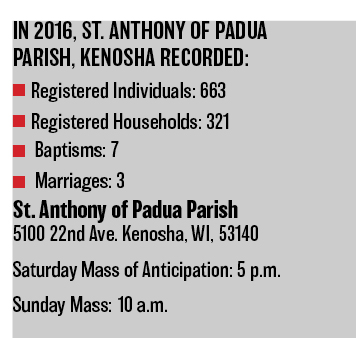
Top: The altar at St. Anthony Parish. Above: St. Anthony in Kenosha was formed by the Slovaks, who came to the United States in the late 1800s. (Photos by Tom Andrews)
In the late 1800s, Catholic Slovaks came to the United States from Austria-Hungary (now known as Slovakia) in search of a better way of life. At that time, a group of Catholic Slovak men decided that it was vital to organize in order to preserve the faith of the Slovak people and, in 1890, the First Catholic Slovak Union of America was established in Cleveland, Ohio.
Other Slovak Unions followed their lead across the U.S. and many of these immigrants found their way to Kenosha in the 1900s. Typically, the men left their families behind and came to America in search of work, got themselves established, and then sent for their wives and families. Kenosha was a prime destination because of the local tannery, where the Slovaks trained, worked and built their American dreams.
In 1906, a group of Catholic Slovak men formed a branch of the First Catholic Slovak Union in Kenosha under the patronage of St. Anthony of Padua and, seven years later, they decided to create a Slovak Catholic church in the city. St. Anthony of Padua Parish was completed Sept. 21, 1913.
“My grandfather was one of the founding members and church was the most important thing in the family,” said Karen Gombar Clair, whose father and other family members have been parishioners since 1929. “I’m very proud of the fact that I’m Slovak and I come to my Slovak parish.”
Masses were held on the upper floor of the original church, with a pastor’s residence and a meeting hall on the first floor. Fr. Victor Blahunka, who was a Slovak-speaking priest, was the first pastor.
As the parish continued to grow, a Ladies Catholic Union and a Catholic Slovak Gymnastic Union Sokol was organized because these early Catholics were known for their interest in gymnastics.
The new St. Anthony church was completed in 1930 under the leadership of Fr. Andrew Lavicka. The original church remains right on the other side of the church parking lot. In 1932, Fr. Michael S. Dutko became pastor and under his careful, astute guidance, the church was able to pay off its debt. That same year, the Women’s Rosary Society was reorganized while the Sodality of the Blessed Virgin Mary was created. The next year, a Holy Name Society was established, and on Sept. 8, 1954, the new St. Anthony’s school was opened with the Dominican Sisters of Oxford, Michigan, serving as teachers.
Barbara Kluka was baptized at St. Anthony on Dec. 31, 1944, and has been a parishioner for 73 years.
“My earliest memories go back to before we had the school,” Kluka recalls fondly. “At that time, we were still using the old church as a meeting place. The kids went there for Catechism classes and we had a community of sisters from New York. They were Franciscans who taught us Catechism, prepared us for first Communion and all of those things. Then in 1954, our school opened and that was staffed by the Dominican Sisters of Oxford, Michigan. There were only five grades and they increased one year, every year, to accommodate children as they aged, so I was able to graduate the eighth grade.”
When Kluka and Gombar Clair are asked to describe St. Anthony of Padua Parish, they are quick to emphasize how very much like a family this church truly is.
“I think it’s a real faith community,” said Kluka. “People by and large know each other or get to know each other when new people from out of town or other parishes join our parish. I’

St. Anthony of Padua is the patron saint of lost articles. (photo by Tom Andrews)
m very pleased with how we have handled social concerns activities. We’ve marched in the Alzheimer’s Walk, sent Christmas packages to the soldiers in Iraq and sent packages for Christmas to kids in college. We’ve also worked with the homeless here in Kenosha, as well as with the Shalom Center, which provides a great deal of social services. Each time I’ve been involved with our parish, it’s something that has helped me to grow spiritually.
“We are a welcoming place and we do our best to greet and welcome new people. We also try to respond to the specific needs that our new or older parishioners have. We’re very, very welcoming.”
“I was baptized in this parish, received my first Communion and confirmation,” added Gombar Clair. “I was married in Texas and was away for 32 years, but I came back here. Everywhere I went, I joined whatever Catholic Church was there. I lived in New Jersey, Texas and Illinois, so I participated in 13 different parishes, and although things in those parishes were interesting and different, it gave me a good perspective when I came back here about things that I would like to do. But I never in any parish (experienced) the familial closeness that (exists) here. We all knew each other and went to school together. We married each other and it was just a family. For me, it was coming home to my family. For me, it had more to do with my Slovak heritage because this was a Slovak parish started by several families initially.
Though one spent three decades away from Kenosha, both of these ladies consider themselves “lifers” at St. Anthony’s. Although Fr. Todd Belardi has been administrator of this parish for just a few years, he already has an appreciation for the history and traditions on display.
“I think each community brings with it its traditions and this is a Slovak parish with its traditions and Slovak culture, which is beautiful,” said Fr. Belardi. “As you can see, they take a great deal of pride in our church. They’ve kept it up extremely well and have taken care of their place of worship. They’re really great people. There are people who have been here for their whole life. I hear many times how people were baptized here, received their first Holy Communion, received their first reconciliation, were confirmed and went to school here. Then they got married and there are some who passed away. So many people have been here their entire lives.”
In describing the “flavor” of St. Anthony’s, Fr. Belardi is straightforward.
“I would say our worship services are in step with the Church and how the Church wants us to celebrate the liturgy,” Fr. Belardi said. “Our music is a mix and we have a beautiful, fantastic organ that was recently restored. So, sometimes we have organ music and sometimes piano music. We have a choir that does a beautiful job with a music director who is helping us.”
As for the future of this storied parish, Fr. Belardi wants those who attend to remain devoted “to the Eucharist and to the Sacrament of Reconciliation. I think we’re making a big step toward that as well as evangelization and getting people to follow Christ as best as possible and to live a life of holiness. When people come here, they will find a beautiful building with great people who really want to love and serve the Lord.”
